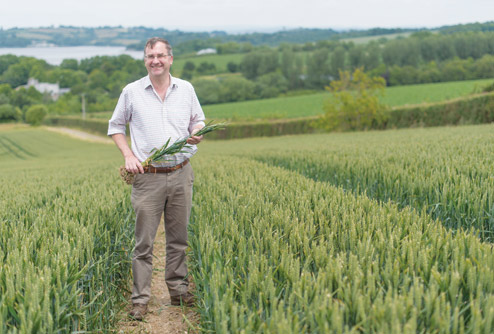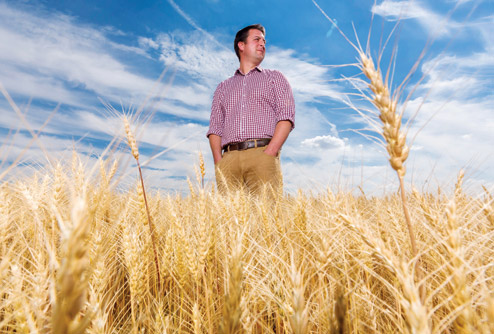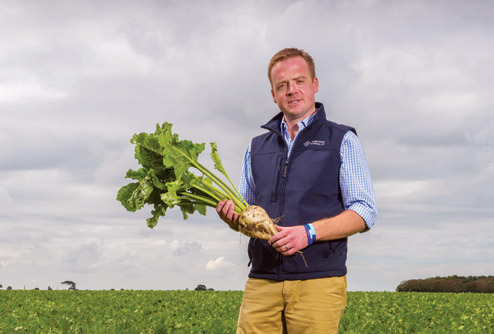2013 Farmers Weekly Arable finalists revealed

All three finalists for Arable Farmer of the Year are first-generation growers, proving that you don’t have to be from farming stock to be a top arable farmer driving your business forward. Richard Allison reports.
Jeremy Oatey
West Antony Farm, Torpoint, Cornwall

Cornwall is more famous for its pasties than its arable farming, but Jeremy Oatey has established a successful arable business by supplying the key ingredients to local manufacturers of the Cornish dish.
His arable business is the largest supplier of peeled onions, swede, potatoes and wheat to local pasty makers, as well as supplying the local NHS trust and food service businesses.
Jeremy’s philosophy to add value and only grow crops for defined local markets also applies to combinable crops, with milling wheat grown to make pastry, milling oats for Morning Foods and Cornish malting barley predominantly supplying St Austell brewery.
The many livestock farmers also means there is a ready demand for feed wheat, which is his biggest crop in terms of area at 280ha, although this year it’s down to 160ha because of the wet winter.
Back in 2004, he established Agricola Growers when he took on a 120ha contract farming opportunity on the Antony estate, near Torpoint, growing daffodils and potatoes. Over the next nine years the business rapidly expanded to 1,080ha and he helped turn around the estate’s vegetable-washing business, which he eventually bought.
FARM FACTS
- 1,080ha being a mix of contract farming agreements and farm business tenancies
- Cropping includes 200ha winter wheat, 138ha potatoes, 117ha oilseed rape, 100ha spring malting barley, 84ha daffodils, 68ha oats; other crops include winter barley, linseed, spring beans, onions and swede.
- Six full-time staff plus sandwich-year student
“We had to do something with the vegetable processing – either it had to go up a gear or we would lose it, as it was not making any money.”
So he managed to secure EU funding to install an onion peeling plant, having identified a local opportunity. “There is massive demand for peeled onions and potatoes for the pasties, but most were coming down from the Midlands. Onions have a very short shelf life once they are peeled, so the fresher, the better.”
His business delivers peeled onions to Ginsters year round and is the sole supplier of potatoes, swedes and onions to the firm.
About 10% of onions are home-grown, but most are bought in from Lincolnshire. “Growing onions is a challenge down here, as the climate means they suffer skin staining.”
He is investing in new drying and storage facilities and hopes to increase the onions grown in Cornwall to 30-40%.
His other premium crops are potatoes and daffodils. Most of his 138ha of potatoes are for processing and the pasty manufacturers prefer yellow, waxy types. The lifting season starts with Premiere, followed by Wilja, then Estima and Melody.
However, it is not just the processing side, Jeremy has gained a reputation as an top arable grower, having only had to tender for 10% of the land when expanding his area over the past nine years, as he was approached by landowners and land agents to take on land.
His secret to his success is understanding what landowners want. “Do what you say you are going to do, don’t promise what you can’t deliver.”
Wheat growing is challenging in the South West, where disease and pest pressure is much greater than the traditional arable areas in East Anglia, but he still averages 8.3t/ha.
“Drilling tends to be later; we can’t drill in the last two weeks of September, as every aphid seems to be down here. The best crops are those drilled from 5-15 October.”
Another key challenge in Cornwall is the variability of the land and he is using technology to bring up the poorer performing areas. Most land has been mapped and he variably applies P, K and lime, with plans to adjust seed rates.
“We are aiming to average 10t/ha and we know we can, as some areas already achieve this.”
The wider Cornish farming community is also benefiting from his experience as chairman of the Kernow Grain co-op and he is a director of Cornwall Farmers.
He also works with his local school, showing children where the key ingredients for the county’s renowned pasty are grown.
James Mayes
Sentry, Shelford, Bedfordshire

When James Mayes took on Sentry Farming’s Bedfordshire and Hertfordshire farms, resistant blackgrass and brome were major challenges, oilseed rape performance was falling and there was no staff succession.
But in the three years since he took on the role he has turned the business around, improving oilseed rape yields, getting blackgrass under control, boosting margins and establishing a more sustainable rotation.
“The rotation was historically wheat/wheat/rape and problems were building. Rape drilling was taking too long, with mixed results. This held up cultivations for second wheat and limited the ability for stale seed-beds,” he says.
Changes began with the rotation, where he introduced spring linseed with oilseed rape grown every four years instead of once every three years.
The other key change was establishment method, with the 285ha of oilseed rape now established using a Claydon strip-till drill. “Before the change, the Simba Solo went through the entire farm every year, with a seeder on top for establishing oilseed rape. But a one-size-fits-all approach was not working.
“Oilseed rape is now drilled in 10-12 days – previously it was taking three weeks, so we effectively brought drilling forward by a week. Seed is drilled in rows 60cm apart with rates reduced to 70 seeds/m.
FARM FACTS
- 850ha mix of contract farming agreements and farm business tenancies
- Cropping includes 420ha winter wheat, 285ha oilseed rape, 115ha red wheat and 30ha linseed
- Two full-time tractor drivers plus two casuals at harvest
“Crops can now branch into the rows and we are seeing a much deeper pod canopy. As a result, yields have risen and are now averaging more than 3.5t/ha, up 1t/ha in just two years. Some fields are now regularly exceeding 4t/ha on the mainly clay over chalk soil.”
This year, he has grown a hybrid (Avatar) for the first time to see if it performs better in the wide-row system. Conventional varieties have traditionally dominated, as most seed is farm-saved.
Another spring crop making an appearance in the rotation is Canadian red wheat, grown on contract from Gleadell to supply Hovis. It accounts for half of the second wheat area, the rest being Scout.
“This is helping with blackgrass control as it is spring-sown – we are using a John Deere disc drill to establish the crop after creating an autumn seed-bed. This means the crop is sown without disturbing the soil, thereby avoiding spring germination of brome and blackgrass.”
The worst areas, however, are ploughed before red wheat.
While yields are lower at an average of 4t/ha, the red wheat brings a premium of £125/t. This means that second wheat has to yield 7.5t/ha to be comparable on margins, says James.
Added to this are the savings in herbicide spend on blackgrass control, which can amount to more than £80/ha, with robust use of herbicides.
“It is helping to tidy up fields and it is really noticeable in following wheat crops. There is still some way to go, but we are now seeing acceptable control,” he says.
Other blackgrass measures include improving drainage and upping seed rates in wheat crops. “Most seed is home-saved and this means we can afford to up rates to increase crop competition.”
James is building local farmer contacts, having hosted oilseed rape open days with Agrovista, as well as other visits. Within Sentry, James is a member of the Farming Development Group, where new ideas and on-farm trial results and experiences are shared, with the aim of improving the wider business, such as his experience with the Claydon strip-till drill.
Being from a non-farming family, he recognises the challenge of attracting new people into farming and enjoys interacting with the next generation. He fulfils a key role in overseeing Sentry’s recruitment of graduates for the company’s established trainee management programme.
It involves visiting universities, talking to and interviewing potential new trainees and giving presentations to student groups such as the Harper Adams Agricultural Society.
His interest in people development has seen a successful reinvigoration of staff morale by getting them involved with the changes and encouraging them to take up training to expand their skills.
Tom Dye
Green Farm, Saxlingham, Norfolk

Getting the most out of the relatively poor north Norfolk soils has been Tom Dye’s key focus in the past two years, which has led to large increases in oilseed rape and sugar beet yields, as well as the successful introduction of double cropping.
A key driver behind the improved crop performance is his interest in nutrition and it has seen him join the exclusive 100t/ha club of sugar beet growers, with one block of land touching 115t/ha.
But during the same period he has controlled costs, seeing only a small increase in fixed costs despite expanding the cropping area by 14%. Staff numbers have remained unchanged, but efficiency has increased to 385ha/man.
He sees his staff as the most valuable asset, with their views included in the decision-making process and an emphasis on training. The result is a fully engaged team with very low turnover.
“Our current combined years of service exceeds 100, including two years for a recently recruited fifth man,” says Tom.
The two crops that have shown most improvement are oilseed rape and sugar beet. Oilseed rape yields have risen by 0.25t/ha with the five-year average now at 4.6t/ha, which is getting close to the 5t/ha holy grail.
FARM FACTS
- 1,917ha mix of contract farming agreements and farm business tenancies
- Cropping includes 760ha winter wheat, 127ha winter barley, 325ha sugar beet, 190ha vining peas, 307ha oilseed rape and 135ha spring barley plus pasture
- Five full-time staff
He puts some of the improvement down to extending the rotation to one in six years by introducing peas and correcting any soil nutrient imbalances.
“I wanted to see if we could get more from what we currently use or apply less to get the same results. It involves carrying out detailed soil and regular plant tissue analyses and then applying tailored mixes.”
Rape crops now receive foliar phosphite in the autumn to help enhance root and shoot growth before winter arrives. This season he tested crops at flowering for nitrogen and on the second round of sampling, levels were found to be low at 2.5%, so received foliar N.
Tom has sourced some turkey manure and hopes to give next season’s crop an autumn boost to create stronger plants quicker.
“Hopefully, the improved autumn growth will help our annual pigeon battle, but also improve the plant’s ability to find nutrients and enhance its drought tolerance,” he says.
The other crop that has seen yields rise is sugar beet, which is managed to produce as high a sugar return as possible. “Last year, we doubled the number of lifts and deliveries to 10 to reduce sugar loss in storage, with no crop sitting on pads for more than a few days.”
Yields have increased from mid-60t/ha to high 70t/ha, with a five-year mean of nearly 80t/ha. In 2011, one 60ha block yielded 102-115t/ha.
Tom has also reduced costs and using GPS alone has saved about £2,000/year in beet seed costs by maximising field efficiency.
Later-lifted crops receive a three-fungicide programme that helps increase yields by retaining green leaf. Like the rape crops, beet receives trace element mixes based on tissue analysis, including the use of zinc as an elemental frost protector.
Growing vetch as a green manure crop after harvesting the previous crop has added an estimated 3t/ha to sugar beet yields. “It captures the leachable nutrients and then provides organic matter and nitrogen to the following sugar beet crop.”
Vining peas are another key crop and Tom is part of the Aylsham Growers’ Co-op. Peas are drilled and harvested early, destined for the “speedy pea” market, with just a 50-minute window between harvesting and delivery.
“We have seen a substantial yield lift in the following wheat crop of about 0.25-0.5t/ha.”
The earlier drilling and harvesting dates with the speedy peas mean there is an opportunity to double-crop a block of land in the rotation. So last year he established a crop of dwarf beans after the peas were harvested in June.
“The beans are harvested in September and then we get a decent crop of wheat, which effectively follows two legumes,” he says.
But it’s not just about maximising yields and margins. Tom also believes farmers have a responsibility towards the environment and wildlife. He has nearly 50ha of ELS-specific crops, helping to provide food and habitats for target species, including grey partridge.
“I am a strong believer that the two roles can go together on the same land.”
Sponsor’s message
 “I was extremely impressed by all three finalists, who demonstrated a very diverse approach and strategy to farming – but all of them are achieving excellent results”
“I was extremely impressed by all three finalists, who demonstrated a very diverse approach and strategy to farming – but all of them are achieving excellent results”
Paul Bee
British Sugar
Find out more about the 2013 Farmers Weekly Awards

